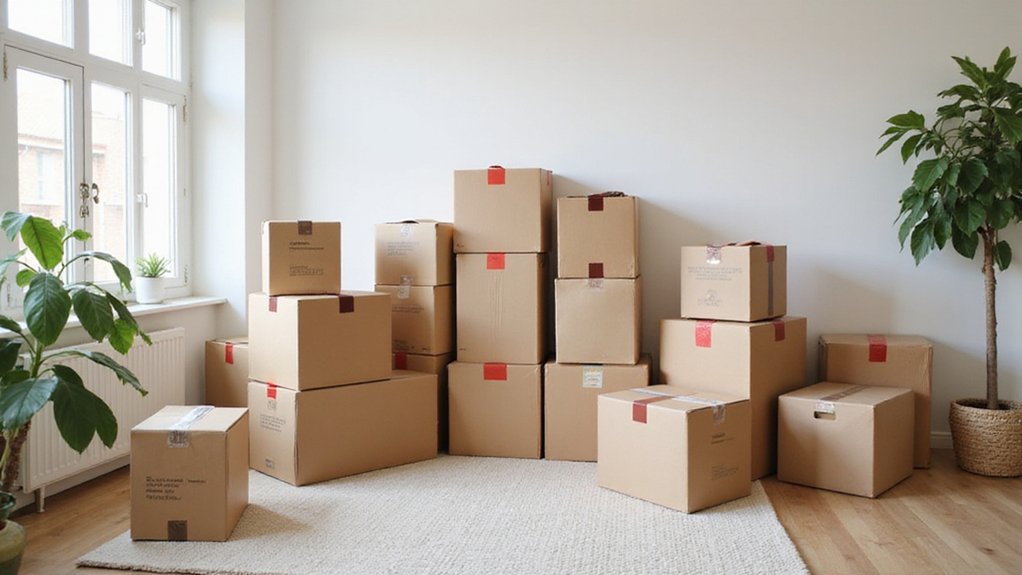Shifting can feel overwhelming, but it doesn't have to be. Whether you're relocating across town or to a new state, strategic planning can transform a potentially stressful experience into a manageable odyssey. You'll uncover that with the right approach, packing and migrating to a new home can be smoother than you might expect. Smart preparation isn't just about boxing up belongings—it's about creating a roadmap that saves you time, money, and unnecessary headaches. Curious how to make your next move your easiest yet?
Key Takeaways
- Start packing non-essential items weeks in advance, creating a progressive moving timeline that reduces last-minute stress and overwhelm.
- Utilize color-coded labels and digital inventory tracking to organize boxes systematically, ensuring quick identification and efficient unpacking.
- Declutter aggressively before moving by sorting items into keep, donate, and discard categories, minimizing overall moving volume and transportation costs.
- Pack strategically by using clothing and linens as protective padding, maximizing space efficiency and reducing the need for additional packing materials.
- Research and book professional moving services early, comparing quotes and checking reviews to secure reliable, cost-effective transportation for your belongings.
Strategic Planning and Preparation
Whether you're relocating across town or to a different state, strategic planning can transform a potentially stressful experience into a seamless migration. Start by prioritizing timeline and evaluating moving budgets weeks in advance. Professional moving services like Syracuse Moving Company can streamline your relocation process across popular routes throughout the East Coast. Create a detailed checklist that breaks down tasks into manageable steps, giving you control over the process. Research moving companies, compare quotes, and schedule services early. Gather packing supplies, declutter unnecessary items, and organize important documents. By planning strategically, you'll reduce last-minute chaos and guarantee a smoother transition to your new home, making the move less overwhelming and more empowering.
Decluttering and Downsizing Your Belongings
After carefully planning your move, the next strategic step involves clearing out unnecessary items and streamlining your personal belongings. Start by sorting your possessions into keep, donate, sell, and discard categories. Focus on minimizing emotional attachment and identifying essentials that truly matter to you. When relocating in the Syracuse, NY area, professional movers can assist with streamlining your moving process.
Ask yourself: "Have I used this in the past year?" If not, it's time to let go. Remember, downsizing isn't about losing memories; it's about making space for new experiences. Tackle one room at a time, and don't overwhelm yourself. Your future self will thank you for this thoughtful process.
Packing Like a Pro: Techniques and Tools
The art of strategic packing can metamorphose a potentially chaotic moving experience into a smooth, organized shift. You'll want to adopt creative packing solutions that optimize your move.
Invest in sturdy, uniform boxes and high-quality packing tape to protect your belongings. Adopt a minimalist moving approach by using clothing and linens as padding for fragile items. Label each box clearly with its contents and destination room, saving you time and frustration later.
Pack heavy items in smaller boxes and lighter items in larger containers to make lifting easier and prevent box breakage.
Smart Labeling and Inventory Management
Because effective labeling can alter your moving experience from stressful to seamless, creating a sturdy inventory management system becomes imperative for a smooth change. Your label design should include box contents, destination room, and fragility indicators.
Color-coded stickers can help movers quickly identify priority boxes and handle them appropriately. Digital inventory tracking apps make cataloging your belongings simple, allowing you to scan and document each item's location and condition. This strategic approach reduces moving day chaos, ensuring nothing gets misplaced or forgotten during your shift.
Hiring and Managing Moving Services
When searching for reliable moving services, you'll want to invest time in thorough research and strategic selection. Compare multiple moving companies by checking online reviews, requesting detailed quotes, and verifying their credentials.
Don't hesitate to negotiate moving rates and ask about potential discounts or price-matching options. Request written estimates and understand the full scope of services included. Check for insurance coverage and inquire about their handling procedures.
Your goal is finding a trustworthy partner who'll treat your belongings with care while offering transparent pricing and professional service.
Settling Into Your New Space Efficiently
After unpacking countless boxes and traversing the pandemonium of a recent move, strategically organizing your new living space becomes crucial for comfort and functionality. Start by implementing the best furniture arrangement that maximizes your space and reflects your lifestyle.
Focus on efficient unpacking strategies, prioritizing essential rooms like the bedroom and kitchen. Unpack systematically, breaking down boxes room by room and placing items in their designated spots. Create zones that promote productivity and relaxation.
Frequently Asked Questions
How Much Should I Tip Movers?
You'll typically tip movers 15-20% of the total bill, or $4-$5 per hour per mover. If they've done an exceptional job, you can increase the recommended tip amount.
Can I Move During Peak Season Without Extra Costs?
You'll struggle to avoid extra costs during peak season, but booking off-peak moving dates and seeking seasonal discounts can help you control expenses and maintain moving flexibility.
What Unexpected Expenses Should I Budget for When Moving?
You'll want to budget for additional storage costs, unexpected utility setup fees, cleaning supplies, possible rental truck damage fees, and potential last-minute packing materials that can quickly add up during your move.
How Do I Protect Fragile Items During Long-Distance Moves?
You'll want bubble wrap, packing paper, and sturdy boxes. Label fragile items clearly. Wrap each piece individually, cushion with extra padding, and mark boxes with "FRAGILE" to guarantee careful handling during your long-distance move.
Are There Tax Deductions Available for Moving Expenses?
You'll find tax deductions for moving are now limited. Only active-duty military members can claim deductible relocation costs when meeting specific tax return filing requirements.



